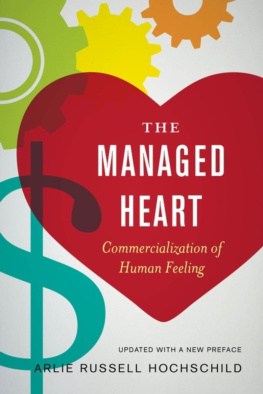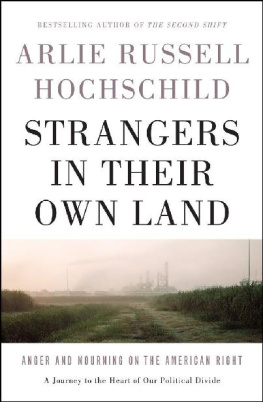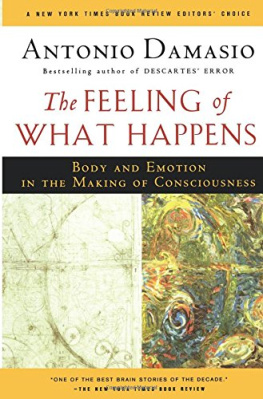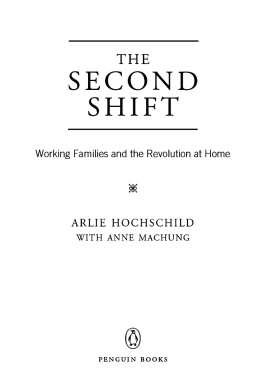The Managed Heart
Other books by Arlie Russell Hochschild:
The Second Shift: Working Couples and the Revolution at Home
The Time Bind: When Work Becomes Home and Home Becomes Work
Global Woman: Nannies, Maids and Sex Workers in the New Economy
The Commercialization of Intimate Life: Notes from Home and Work (UC Press)
The Outsourced Self: Intimate Life in Market Times
The Managed Heart
Commercialization of Human Feeling
Updated with a New Preface
ARLIE RUSSELL HOCHSCHILD

UNIVERSITY OF CALIFORNIA PRESS
Berkeley Los Angeles London
University of California Press, one of the most distinguished
university presses in the United States, enriches lives around the
world by advancing scholarship in the humanities, social sciences,
and natural sciences. Its activities are supported by the UC Press
Foundation and by philanthropic contributions from individuals and
institutions. For more information, visit www.ucpress.edu.
University of California Press
Berkeley and Los Angeles, California
University of California Press, Ltd.
London, England
1983, 2003, 2012 by
The Regents of the University of California
First paperback printing 1985
Library of Congress Cataloging-in-Publication Data
Hochschild, Arlie Russell, 1940.
The managed heart : commercialization of human feeling / Arlie Russell Hochschild.
p. cm.
Includes bibliographical references and index.
ISBN 978-0-520-27294-1 (pbk. : alk. paper)
1. EmotionsEconomic aspects. 2. WorkPsychological aspects. 3. Employee motivation. I. Title.
BF531.H62 2012
152.4dc21
2003042606
Manufactured in the United States of America
20 19 18 17 16 15 14 13 12
10 9 8 7 6 5 4 3 2 1
The paper used in this publication meets the minimum requirements of ANSI/NISO Z39.48-1992 (R 2002) (Permanence of Paper).
For Ruth and Francis Russell
Contents
Preface to the 2012 Edition
As I sat five rows back in a Recurrent Training room at the Delta Airlines Stewardess Training Center in the early 1980s, listening to a pilot tell recruits to smile like you really mean it, I remember noticing the young woman next to me jotting down the advice verbatim. I had already been talking for months to flight attendants from various airlines, interviews that are reflected in this book. So I had a sense of what feelingsanxiety, fear, ennui, resentment, as well as an eagerness to servemight underlie that smile.
It was that pinch, or conflict, between such feelings and the pilots call for authenticity that led me to write down in my own notebook, emotional labor. Never did I dream that thirty years later, seated at my computer and exploring the Internet, I would discover some 559,000 mentions of emotional labor or labour, and its unpaid form, emotion work. In their Emotional Labor in the Twenty-first Century, Alicia Grandey, James Diefendorff, and Deborah Rupp discovered over ten thousand mentions of emotional labor (or labour) in academic articles, half of them since 2006, and 506 with the term in the title.
Im pleased that the idea has caught on but the real reason for such a burst of interest in the subject is, of course, the dramatic rise in the service sector itself. Indeed, as contributors to the American gross domestic product, the manufacturing sector has declined to 12 percent while the service sector has risen to 25 percent. Day-care centers, nursing homes, hospitals, airports, stores, call centers, classrooms, social welfare offices, dental officesin all these workplaces, gladly or reluctantly, brilliantly or poorly, employees do emotional labor.
But how much of it do they do? And in what way? R. Cross, W. Baker, and A. Parker call some employees energizers. Their job is to deliver bad news and, often, to receive the brunt of customer frustration, despair, and rage. And finally there are those who dont so much handle the bad news of others as face a real chance of experiencing pain or loss of their own: soldiers, firefighters, high-rise window-washers, and professional football players, for example.
Other forms of emotional labor require that a person manage a wide range of feeling. The poor salesclerk working in an elite clothing boutique manages envy. The Wall Street stock-trader manages panic. The judge, as legal researcher Terry Maroney shows, is exposed to highly disturbing evidence of atrocities such as maiming, murder, dismemberment, and child rape. He or she must face the task of acknowledging and managing such feelings as horror, outrage, indignation, and pity, all the while maintaining the semblance of impartiality.
Emotional labor can be hard to recognize. We can, for example, feel schadenfreude, or pleasure at the misfortune of others, a feeling we may be ashamed to have. And our shame can get in the way of the very act of acknowledging that feeling. Thats important because it is the pinch between a real but disapproved feeling on the one hand and an idealized one, on the other, that enables us to become aware of emotional labor. We may feel lonely at a joyous holiday party, relieved or indifferent at a funeraland call on ourselves to correct our feelings. These kinds of pinches are of little consequence in certain cultures, and of great consequence in others, for cultures carry different feeling rules. When I talked about emotional labor to Japanese people, they didnt know what I was talking about, Batja Mesquita, a psychologist at Leuven University in Belgium told me. So for the Japanese, emotional labor is more built in and therefore harder to see.
Cultural rules are seeing rules. And seeing is a matter of thinking about what we see. Based on our habits of thinking about emotion, we then recognize emotion in ourselves and others in an intricate variety of ways. Ironically, cultures which require the most emotional laborand may be home to its most highly-trained practitionersmay also be those that inhibit the very recognition of it. Batjas observation leads us to the broader question of how cultural rules inhibit or highlight the very ways we see and think about emotion. Many Japanese do recognize emotional labor, of course (The Managed Heart has been translated into Japanese, Chinese, and Korean). And the emotional labor a Japanese observer may see more keenly than her American counterpart might be that which it takes to uphold the belief inand indeed fantasy ofthe stand-alone individual.
Tellingly, in the United States, the idea of emotional labor has been embraced by business advice gurus as an undiscovered resource and means of competitive advantage, and by labor unions as a cause of burnout, deserving of financial compensation. So where should we look to understand current trends in emotional labor? To the most powerful economic trends of our time, I believe: the profit-seeking drive for efficiency, the downsizing of public services, the growing gap between rich and poor, and globalization. Each of these trends fosters situations which call for emotional labor.
Speaking of modern American hospitals, one commentator observed, Most hospitals used to be community-based and non-profit. Over the last three decades, the trend has been toward for-profits, but whether American hospitals are non-profit or for-profit, increasingly they are run according to business principles. The Beth Israel Hospital in Boston provides one example. It was once a model of primary nursing care, but then merged with another hospital and restructured. Nurses formerly assigned to a particular group of patients were now assigned to float from unit to unit, depending on the number of beds filled on a given day. Staff was laid off. Stripped from the nurses role were tasks now defined as menialpositioning a post-surgical patient on a chair, feeding an elderly patient, or helping him to the bathroom. Such tasks were now assigned to untrained, lower-paid workers.
Next page











